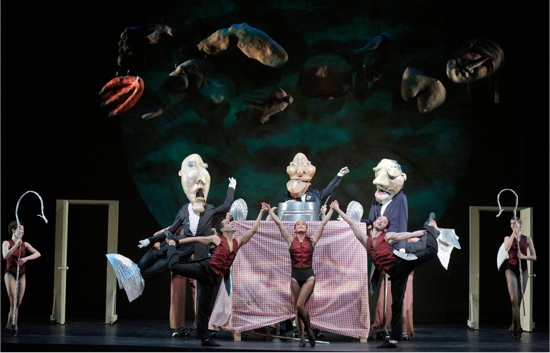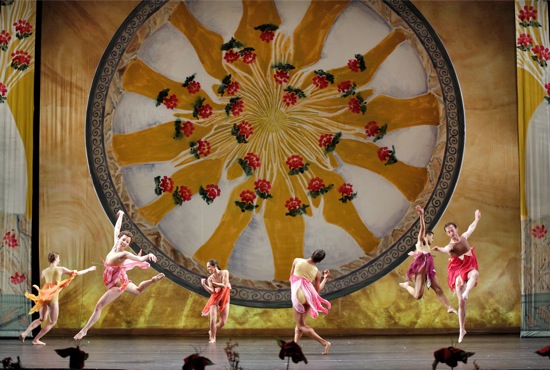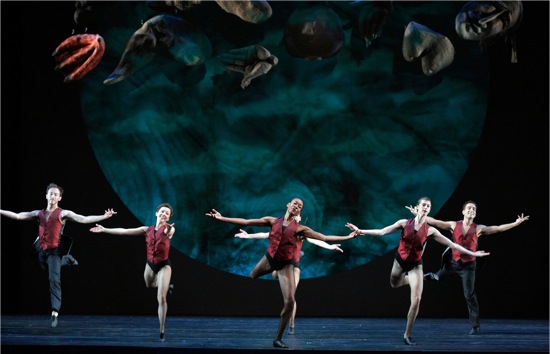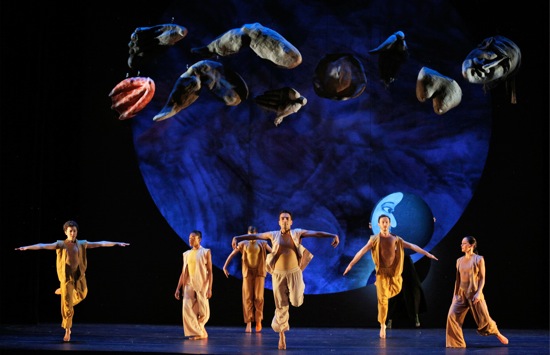Fantasque by John Heginbotham and Amy Trompetter opens Bard Summerscape 2016.

A scene in Fantasque by John Heginbotham and Amy Trompetter. Dancers (L to R): Macy Sullivan, John Eirich, Courtney Lopes, Weaver Rhodes, and Lindsey Jones; puppeteers (L to R): Gregory Corbino, Maura Gahan, and Gabriel Harrell. Photo: Cory Weaver
The 2016 season of Bard Summerscape (July 1 to August 14) is devoted to the opera composer Giacomo Puccini. Hosted by the Richard B. Fisher Center for the Performing Arts at Bard College, the concerts, lectures, panels, films and performances that comprise “Puccini and His World” pop up at various sites on the campus in Annandale-on-Hudson.
No composition by Puccini was heard in the Sosnoff Theater on opening night, but he lurked beneath the credits for Fantasque, a collaboration between choreographer John Heginbotham and puppet builder and puppeteer Amy Trompetter (he was a member of the Mark Morris Dance Company for fourteen years; she toured with Bread and Puppet Theater for nineteen). The music for two out of the ten sections in this charming two-act performance is recorded: selections from Ottorino Respighi’s score for La Boutique Fantasque, composed for Serge Diaghilev’s Les Ballets Russes and premiered with choreography by Léonide Massine.
Heginbotham and Trompetter acknowledge as a source that 1919 ballet about a toy store come to life in aid of two dolls, in love but about to be separated. Respighi, however, had based most of his score on some of the 140 pieces that make up Giacomo Rossini’s Peches de viellesse (Sins of Old Age). Heginbotham used a number of these piano pieces in his Fantasque. And Puccini? Where does he fit in? Well, he was ten years old when Rossini died in 1868, but, although he was almost twenty years older than Respighi, around the turn of the twentieth century and until Puccini’s death in 1924, both were part of the Italian musical landscape.
Fantasque doesn’t exactly pursue a narrative, although one threads through it. In an interview, Heginbotham said that he thought of the production’s scenes happening simultaneously rather than sequentially and joining together onstage as unexpectedly as actions in dreams do. Watching the work, delighted, I admit to not always grasping the collaborators’ overall theme, expressed in an interview printed in the program: that “the environment is being corrupted through villainy” and that extinction looms. That idea is most clearly expressed in a scene in which three hideous, big-headed gentlemen in suits but with fish tails gather around a table to feast. When the cover is removed from the platter, a swarm of little fishes is wriggling there. The corporate bigfish grab them by the fistful and gobble them up. But we are to believe that this is a tale told by sly red devil (a full body puppet), and, when the meal is done, the eaters get the hook and are dragged offstage by the dancers).
Trompetter’s décor, together with Nicole Pearce’s lighting, expresses the changing earth more obliquely. After pianist George Shvetsov strides onto the stage (more about that later!) and begins to play Rossini’s “Petite caprice (style Offenbach,” ten beige panels descend, two by two, on either side of the stage to create wings. The drop that fills the back of the stage frames a large empty circle. After the cast has been introduced—puppets and dancers—a mottled gold disk descends to fill that frame. Later in Fantasque, it darkens, then a beige circle obscures it, and in the final optimistic scene, painted flowers radiate in that circle, the original panels are replaced by flowered ones, and window boxes of flowers appear as if by magic to edge the front of the stage.

The final dance in Fantasque. (L to R): Lindsey Jones, Macy Sullivan, Courtney Lopes, Kristen Foote, John Eirich, Weaver Rhodes. Photo: Cory Weaver
In the sequence titled “The Birth of the World,” the dancers act as creators to assemble Mother Earth. Frolicking intermittently, they run on, one at a time bearing the papier maché (?) body parts of a gigantic female. No effort is made to join them together; they pile up and later will be hooked onto wires and hoisted up to hang above the onstage events. In addition to the Devil (wonderfully sly as manipulated by Gregory Corbino), there’s a doughy, bandy-legged baby puppet (handled by a crouched-down Ethan Rogers), born of a union between two dancers (Lindsey Jones and John Eirich). A blue-faced “angel-mother” with a billowy smock that conceals its puppeteer(s) tends the infant, tickling it and hovering over it with tender, willowy grace. A tiny rat becomes its pet (Kedian Keohan) crawls with the puppet, fully visible, and squeaking occasionally).
Several huge rat puppets appear as well; it is they, summoned by the tiny one, who gnaw through the big fish net that the devil conjures up to trap everyone who arrives for the costume party he’s giving and free the victims. And, near the end, the three main puppeteers (Corvino, Maura Gahan, and Gabriel Harrell) enter beneath the gown of an immense goddess whose rat-head reaches many feet into the air. The final celebration and the flowers must be her doing. The earth is reborn. (I’m wondering if Heginbotham and Trompetter read Elizabeth Kolbert’s The Sixth Extinction, which postulates a day when rats will take over the earth).
There are witty inventions in Fantasque, such as a ball game for the baby, and I like the fact that the Devil doesn’t show himself as out-and-out evil; he just likes assisting in the end of our world. If we don’t care about saving the planet, he might as well have some fun. There are also a few enigmas, such as an old-woman puppet sitting in a chair beside an empty rocking chair. What does it mean when the seven dancers appear each wearing one orange shoe? Why at the Devil’s ball, do the dancers don red vests (by Maile Okamura) with what appear to be a curved silver blade attached to the back of each?

Fantasque by John Heginbotham and Amy Trompetter at Bard Summerscape 2016. (L to R): Weaver Rhodes, Macy Sullivan, Kristen Foote, Lindsey Jones, and John Eirich. Photo: Cory Weaver
One initial mystery becomes deliciously clear later. When Shevtsov enters, he doesn’t walk like most pianists; he’s all in black, maintains an erect posture, and you can hear the click of his heeled boots on the floor. Hmm, you think. It’s not a huge surprise when he rises from the piano bench during the interlude between Act 1 and Act 2, walks to the center of the stage, and begins to dance. I can’t think of any other pianist who plays the instrument as dazzlingly as he does who is also an accomplished flamenco dancer. His heelwork matches in nimbleness and rhythmic potency his fingers’ dance on the keyboard. And—this is a fine touch—he doesn’t direct his dancing at us; he’s doing it to entertain the baby.
I haven’t made it clear that the dancers thread through all this. Usually they work together—whether around the puppets or as the only people onstage. But Heginbotham has choreographed a short, sweet duet for Jones and Eirich that begins with them pressed together face to face, as if to illustrate Aristophanes’ speech at Plato’s symposium that has man and woman originally joined as one being. He lies down, she stands on his chest, and he rotates, as if to show us all the aspects of his mate. In the end, they rub their foreheads together

Beneath Mother Earth’s body parts in Fantasque: (L to R) Macy Sullivan, Kristen Foote,, Lindsey Jones, John Eirich, Weaver Rhodes, and Courtney Lopes. Photo: Cory Weaver
As individuals and as an ensemble, Jones, Eirich, Kristen Foote, Courtney Lopes, Weaver Rhodes, Elisa Schreiber, and Macy Sullivan are always engrossing to watch (Sullivan in particular has some vivid passages). Heginbotham approaches the music with sensitivity, capturing Rossini’s lively or lyrical, essentially sweet-tempered qualities. As a choreographer, he shapes passages of dancing with a wise eye to contrasts in scale, design, and rhythm. Sometimes, a slight twist makes what might have started out as a conventional pattern give you a gentle surprise. The dancers do everything they need to do to move the action forward or handle props, but they dance at the drop of a hat, and by the end of Fantasque, everyone is in flowery attire. Amid the celebration, puppeteer Corbino, unmasked and wearing a long skirt suddenly bursts into song, and Heginbotham and Trompetter join the performers in watching him serenade them—and us. So the world will continue a while longer?

I am so pleased to see the photographs of Macy Sullivan, and your special mention of her Deborah. Macy got her initial training at the School of Oregon Ballet Theatre, particularly from Josie Moseley. Christopher Stowell, when he directed the company, considered her to be extremely gifted and intelligent. And I interviewed her for I can’t remember which publication, maybe Dance Magazine, and it was as much a pleasure to interview her as it was to watch her dance. So thank you very much and this looks like extremely interesting work.